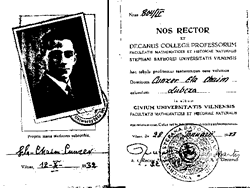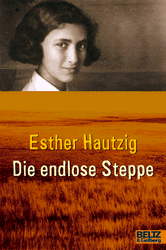Ela-Chaim Cunzer' Modern Holocaust Memorial: Thesis of Victim on Internet
http://query.nytimes.com/gst/fullpage.html?res=9807E2D61E39F932A15757C0A960958260&sec=&spon=&pagewanted=2
By JOSEPH BERGER
Published: April 21, 1996
Ela-Chaim Cunzer died in the winter of 1944, far from his family,
without a tombstone, without even a grave. His life was truncated
before its vivid promise could be realized, his mathematical work and
dreams reduced to a single digit among the digits that added up to the
six million Jews who died in the Holocaust.
But his niece, Esther Hautzig, could not abide such anonymity for an
uncle she knew as a slender young man with deep-set dark eyes and a
shy half-smile who played the violin and would tug at his hair in
exasperation whenever he helped her with multiplication. She wanted to
restore what the Nazis had destroyed: the evidence that he had lived
and worked.
She has done that now. After a sinuous journey, she has unearthed the
masterwork of Mr. Cunzer's short life, his handwritten 49-page
master's thesis for the University of Vilnius in Lithuania. And the
University of Chicago has deemed it worthy of a place in its library
and on its Internet site at www.math.uchicago.edu/history.
www.math.uchicago.edu/history/1937_thesis.html
As Jews at this time of year hold Holocaust memorials in recognition
of such anniversaries as the Warsaw Ghetto uprising, the fact that her
uncle's work has been memorialized in this thoroughly modern way is an
amusing trick of history to Mrs. Hautzig. But her quest also reflects
a growing notion among survivors that, beyond remembering the
cruelties of the Holocaust, it is important to recall the lives and
culture that were snuffed out.
"At least here is proof, some more proof of how people lived and what
they did, not that they died," Mrs. Hautzig said. "He really was a
student. He really worked hard. He really wrote this dissertation. And
it resulted in something which is still here."
Unearthing her uncle's work began with a sometimes-heartbreaking,
sometimes-lilting journey in 1993 to the hometown she knew as Vilna, a
trip her mother had warned her to avoid because it would spoil rosy
childhood memories. All she sought there was her uncle's university
application so she could have a photograph of him. That she ended up
with a dissertation on the Internet resulted from a combination of
luck, Mrs. Hautzig's exuberance and help from many professors
captivated by a remarkable adventure.
Mrs. Hautzig's pursuit, for example, had a personal resonance for Dr.
Robert Fefferman, chairman of the mathematics department at the
University of Chicago. He was a colleague of Mr. Cunzer's mentor, the
late Antoni Zygmund, and his mother fled Nazi Germany for the United
States. He said he promptly decided to accept the thesis, titled "On
Convex and Subharmonic Functions," because he judged it to be "a
beautiful piece of work on an important topic."
"Obviously, he was a brilliant student," Dr. Fefferman said. "It's
good mathematics and it has great historical and emotional appeal."
Mrs. Hautzig, a spirited 65-year-old author of children's books who
lives on Manhattan's West Side, grew up in Vilna, now Vilnius, a city
of baroque buildings that was then part of Poland. Its community of
57,000 Jews produced the fabled Tamudic scholar the Gaon of Vilna, the
violinist Jascha Heifetz and the Yiddish poet Abraham Sutzkever. Fewer
than 3,000 Vilna Jews survived the Holocaust.
To the young Mrs. Hautzig, Vilna was the 16th-century castle whose
grounds she capered on with her cousins, the fragrance of lilacs in
her courtyard and the charms of her uncles and aunts. One of those was
her mother Raya's brother, Ela-Chaim, whom she called by his Polish
nickname, Liusik. Born in 1914, he was 16 years older than Mrs.
Hautzig, who was then Esther Rudomin.
She knew him as the family math genius, someone, she wrote, "who often
seemed preoccupied, as if his attention was centered on faraway,
important matters." From 1932 to 1937, he attended the University of
Vilnius, a protege of Dr. Zygmund, one of the century's great
mathematicians, famed for his work on the mathematics of vibrating
objects that proved crucial to spacecraft design. Ela-Chaim and his
younger sister, Margola, a chemistry student, often stopped by the
Rudomin home, and Ela-Chaim sometimes helped Esther with her
multiplication tables. When he asked "How much is three times four?"
and she answered "13," he looked shattered.
"Liusik, Liusik, let it be 11, just don't be angry with me!" she
remembers responding.
In June 1941, after the Soviet Union occupied Poland and Lithuania as
part of the pact between Stalin and Hitler, Mrs. Hautzig, then 10, her
father and her mother were sent to Siberia by officials who accused
them of being capitalist "enemies of the people." The family's
deportation saved their lives because they were far from the massacres
in the Ponary forest that came with the Nazi invasion of Vilna.
Her uncle was not so lucky. Mrs. Hautzig tells of an incident
reminiscent of the split-second, life-and-death decision of the novel
"Sophie's Choice." When the Soviet police came to the Rudomins' door
to deport them, Ela-Chaim showed up and Mrs. Hautzig's mother told
them: "I never saw him before in my life." Had she told the truth,
Mrs. Hautzig says, Ela-Chaim might have joined the Rudomins in
Siberia.
Instead, Ela-Chaim, Margola and their mother were trapped in the Vilna
ghetto. Hiding in an attic, he studied mathematics, played violin in
the ghetto orchestra and helped save irreplaceable volumes of the
Yiddish Scientific Institute from the Nazis' mocking plans to set up a
Jewish museum.
Eventually, he was sent to a concentration camp in the Estonian port
of Narva, where he contracted typhus and died in early 1944 at 30.
Mrs. Hautzig came to the United States in 1947, met her husband,
Walter, a concert pianist, had two children and in 1968 wrote about
her Siberian experience in "The Endless Steppe." In July 1993, she
decided to join 600 survivors in Vilna to mark the 50th anniversary of
the ghetto's destruction. Walking Vilna's streets, she says, she "had
a strong feeling of seeing the dead walking among the living."
At the university, Mrs. Hautzig asked a Jewish student, Rokas Oginkis,
if he could locate her uncle's application. On the following Hanukkah
-- Mrs. Hautzig thinks of it as a miracle -- a package of photocopies
arrived that included her uncle's records and the thesis, which she
had not known about.
"I cried," she recalled. "I held it like I would hold a letter. I kept
looking at it and touching it. The clear handwriting with all these
pages, 49 pages."
Though she speaks Polish, the thesis' arabesque formulations on
electronics meant little to her and she thought an English translation
might help. In December 1994, an academic friend sent out a call for
help on an electronic bulletin board. One of the five mathematicians
who responded was Krzysztof Wlodarski, a Polish-born doctoral student
at New York University. His gentle voice and devotion to his work
reminded her of her uncle and she remembers thinking: "There is the
man who will do it right."
The translation, though, was not enough. Mrs. Hautzig wanted the
thesis to be a living work available to scholars, so she wrote Dr.
Fefferman.
To Mrs. Hautzig, having her uncle's thesis on the Internet is similar
to her placement of a photograph of her grandfather, Solomon Rudomin,
clutching young Esther, on the jacket of her 1990 memoir, "Remember
Who You Are."
Her father, Samuel, once told her that her grandfather, who perished
in a Soviet labor camp, was buried without a tombstone, but the book
jacket photograph serves as a monument to his life.
"That'll be his gravestone," Mrs. Hautzig said of her uncle's spot on
the Internet. "And it can be called up any time
Esther Hautzig
BIOGRAPHY
Esther Hautzig is the author of many books for children and adults.
The Endless Steppe is an autobiographical account of her childhood in
Siberia. It was a 1969 National Book Award nominee and an ALA Notable
Children's Book of 1968. It also received the 1969 Jane Addams
Children's Book Award and the 1971 Lewis Carroll Shelf Award. Mrs.
Hautzig is also the author of Riches, an original Jewish folktale,
which was a finalist for the 1993 Jewish Book Award. She lives in New
York City.
Esther Hautzig (née Rudomin) (October 18, 1930) is a Jewish-American
writer, best known for her award-winning book The Endless Steppe
(1968). She was born in the then Vilna, Poland (Vilnius, Lithuania
today). Her happy childhood was rudely interrupted by the advent of
World War II and the conquest in 1941 of eastern Poland by Soviet
troops. Her entire family was uprooted and deported to Siberia, where
Esther spent the next five years in harsh exile. The Endless Steppe is
an autobiographical account of those years in Siberia.
After the end of the war, Esther and her family moved to the United
States. She married Walter Hautzig, a concert pianist, and bore him
two children, David and Deborah, both of whom grew up to be children's
authors.

